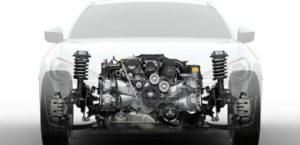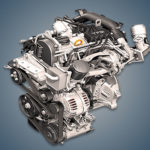The 1.4-liter 16-valve Volkswagen BUD engine was produced from 2006 to 2010 and was installed on a number of popular models such as Golf, Polo, Cuddy, as well as Fabia and Octavia. This motor replaced a similar BCA power unit on the conveyor and gave way to the CGGA.
The EA111-1.4 series includes: AEX, AKQ, AXP, BBY, BCA, BUD, CGGA, CGGB.
Specifications
| Production years | 2006-2010 |
| Displacement, cc | 1390 |
| Fuel system | injector |
| Power output, hp | 80 |
| Torque output, Nm | 132 |
| Cylinder block | aluminum R4 |
| Block head | aluminum 16v |
| Cylinder bore, mm | 76.5 |
| Piston stroke, mm | 75.6 |
| Compression ratio | 10.5 |
| Features | DOHC |
| Hydraulic lifters | yes |
| Timing drive | belt |
| Phase regulator | no |
| Turbocharging | no |
| Recommended engine oil | 5W-30 |
| Engine oil capacity, liter | 3.2 |
| Fuel type | petrol |
| Euro standards | EURO 4 |
| Fuel consumption, L/100 km (for VW Polo 4 2008) — city — highway — combined |
8.3 5.2 6.3 |
| Engine lifespan, km | ~275 000 |
The engine was installed on:
- Volkswagen Caddy 3 (2K) in 2006 – 2010;
- Volkswagen Golf 5 (1K) in 2006 – 2008;
- Volkswagen Golf Plus 1 (5M) in 2006 – 2010;
- Volkswagen Polo 4 (9N) in 2006 – 2009;
- Skoda Fabia 1 (6Y) in 2006 – 2007;
- Skoda Octavia 2 (1Z) in 2006 – 2010.
Disadvantages of the VW BUD engine
- This engine is considered average in terms of reliability and, moreover, it is quite noisy.
- The main causes of floating engine speeds are throttle or EGR contamination.
- Due to poor design, the oil receiver is often clogged, which is dangerous for the engine.
- Timing belts have a low resource, and the valves bend when at least one of them breaks.
- Also, the network complains about oil leaks and quick failure of ignition coils.







I cannot seem to find the spark plug gap for my son’s 1.4 petrol (80BHP) MK5. I want to find it before replacing them. I have the manual, but the gap isn’t in there.
Pozdrav
Uradio sam prvi veliki servis na VW polo 2008 motor 1,4 16 V 59 kw benzin oznaka BUD na 75800 km auto je staro 15 godina. Dijelovi su bili prva ugradnja (orginal).
Stanje je bilo slijedeće:
1. veliki remen iznutra nije bio istrošen ali su se na vanjskom dijelu remena kad se savije vide sitne male pukotine.
2. mali remen se sa vanjske strane malo slizao.
3. vodena pumpa malo je procurila.
Zaključak, na vrijeme sam uradio veliki servis. Auto sam kupio prošle godine a prehodni vlasnik nikad za 14 godina nije radio veliki servis na spomenutom autu.
Ovo sam podijelio iskustvo kako bi pomogao onima koji su u dilemi treba li ili Ne uraditi veliki servis u ovakim ili sličnim situacijama. Moj zaključak je Da trebaju, bez obzira šta piše u servisnom upustvu.
Google.Translate:
Greetings
I did the first major service on a VW polo 2008 engine 1.4 16 V 59 kw petrol mark BUD at 75800 km the car is 15 years old. The parts were the first installation (original).
The situation was as follows:
1. the large belt was not worn from the inside, but on the outer part of the belt when it is bent, small cracks are visible.
2. the small strap was slipping a little on the outside.
3. the water pump leaked a little.
Bottom line, I did a great service on time. I bought the car last year, and the previous owner never did a major service on the mentioned car in 14 years.
I shared this experience to help those who are in a dilemma whether or not to do a major service in this or similar situations. My conclusion is that they should, regardless of what is written in the service manual.
My car is a 1.4 polo mk4
This exact engine
Got a rocker cover gasket leak. Slightly minute, but it’s leaking.
Gearbox leak also but works as a charm.
It’s done 96k miles is it worth getting anything done to it soon? I only want it for a year or two and then I’ll either keep it for a project car or sell it on.
Kad se radi veliki servis na ovom motoru?
Servisno upustvo kaže kontrola zupčastog na 90.000 km + 30.000 km. Nema naznačeni vremenski period npr. 5, 7 godina bez obzira na pređene kilometre dok za druge vrste motora ima.
Google Translate:
When is the major service done on this engine?
The service manual says to check the gear at 90,000 km + 30,000 km. There is no specified time period, for example 5, 7 years, regardless of the kilometers driven, while there is for other types of engines.
Ja radim na nekih 100 000km, čisto preventivno. Obično se menja na 120 000km, ali ja ne bih čekao toliko jer nisu delovi kvalitetni kao nekad. Što se tiče vremena, možeš menjati i na nekih 7 godina ako ne pređeš više od 100 000 km.
Google.Translate:
I work on some 100,000 km, purely as a preventive measure. It’s usually changed at 120,000km, but I wouldn’t wait that long because the parts aren’t as good as they used to be. As for the time, you can change for about 7 years if you don’t drive more than 100,000 km.